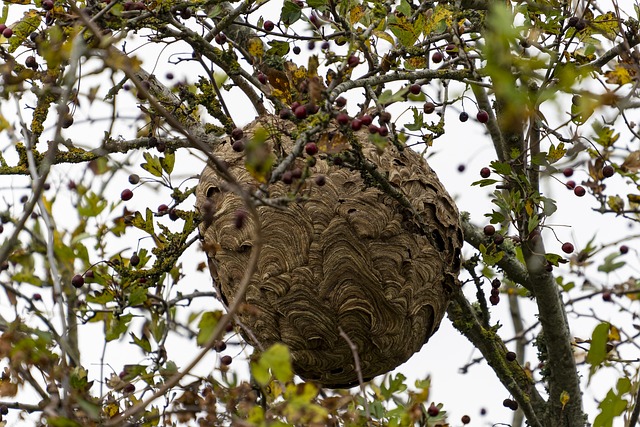Understanding hornet behaviors and environmental needs is key to implementing effective, eco-friendly hornet prevention strategies. Researchers are turning to natural alternatives like neem oil, citronella, lavender, and peppermint oils for long-term protection without harming the environment. Innovative technologies such as ultrasonic waves and specific light wavelengths also offer sustainable solutions, suitable for residential and commercial areas. Integrated Pest Management (IPM) focuses on biological, cultural, environmental, and chemical controls to prevent infestations and reduce the need for chemicals, promoting a balanced ecosystem.
In the pursuit of harmonious coexistence with nature, exploring advanced technologies for long-term hornet deterrence is paramount. Hornets, known for their aggressive behavior and environmental impact, demand innovative solutions. This article delves into understanding these insects’ unique behavior and needs. We explore eco-friendly deterrents, from natural repellents to cutting-edge ultrasonic waves and light-based controls. Additionally, it highlights the power of integrated pest management, offering a comprehensive, sustainable approach to achieving effective and eco-friendly hornet prevention.
Understanding Hornet Behavior and Their Environmental Needs
Hornets, like all insects, have distinct behaviors and environmental requirements that understanding is key to effective deterrence. To implement advanced, eco-friendly hornet prevention strategies, it’s crucial to comprehend their life cycle and what attracts them. Hornets are highly organized social insects with specific nesting sites and food preferences. By studying these aspects, researchers can develop targeted solutions that disrupt their activities without causing harm to the environment or other beneficial insects.
Their need for shelter, particularly during certain stages of their lifecycle, makes them vulnerable to strategic deterrents. Eco-friendly prevention methods might include using natural repellents, modifying nesting site accessibility, and eliminating food sources. By addressing these factors, it becomes possible to create a long-term solution that coexists harmoniously with nature while keeping hornet populations under control.
Exploring Eco-Friendly Deterrents: Natural Repellents and Solutions
In the pursuit of effective yet sustainable solutions for hornet deterrence, exploring eco-friendly options has emerged as a promising avenue. Traditional chemical repellents often leave a detrimental impact on the environment and local ecosystems. As such, researchers and pest management professionals are increasingly turning to natural alternatives that can provide long-term protection without compromising ecological balance.
One of the most widely studied natural hornet deterrents is neem oil, derived from the neem tree (Azadirachta indica). This bio-pesticide not only repels hornets but also disrupts their growth and reproduction cycles due to its insecticidal properties. Additionally, plant-based essential oils like citronella, lavender, and peppermint have shown promising results in repelling hornets due to their strong aromas. Integrating these eco-friendly solutions into agricultural practices and urban pest management strategies offers a sustainable approach to long-term hornet prevention, ensuring both environmental conservation and effective control.
Innovative Technologies: Using Ultrasonic Waves and Light for Hornet Control
Innovative Technologies: Ultrasonic Waves and Light Offer a Green Approach to Hornet Control
In the pursuit of eco-friendly hornet prevention, researchers have explored advanced technologies that go beyond traditional methods. One promising approach involves the use of ultrasonic waves and specific wavelengths of light. Ultrasonic devices emit high-frequency sound waves that are inaudible to humans but can disrupt hornets’ communication and navigation systems, effectively deterring them without causing harm. This technology is not only humane but also environmentally friendly, as it avoids the use of chemicals or harmful pesticides.
Additionally, strategic lighting designs have shown potential in hornet control. Certain light wavelengths are known to attract and trap hornets, allowing for their safe capture and relocation. By integrating these lighting systems into structures or areas prone to hornet infestations, it becomes possible to reduce their presence without causing ecological disruption. This dual approach of ultrasonic waves and targeted lighting offers a sustainable solution to long-term hornet deterrence, catering to both residential and commercial settings.
Integrated Pest Management: A Comprehensive Approach for Long-Term Prevention
Integrated Pest Management (IPM) offers a comprehensive and eco-friendly approach to long-term hornet deterrence, moving beyond traditional pest control methods. This strategy involves a combination of biological, cultural, environmental, and chemical controls tailored to specific hornet habitats and behaviors. By understanding the complex relationships between hornets, their prey, and the ecosystem, IPM aims to prevent infestations and minimize the need for chemical interventions.
Eco-friendly hornet prevention through IPM includes practices like habitat manipulation—removing potential nesting sites—and the introduction of natural predators such as birds and spiders. Additionally, using pheromone traps can help monitor and control hornet populations effectively without harming beneficial insects. These methods not only discourage hornets from settling but also promote a balanced ecosystem, ensuring that these pests do not become a persistent issue over time.
In conclusion, a multi-faceted approach combining understanding hornet behavior, eco-friendly deterrents, innovative technologies like ultrasonic waves and light, and integrated pest management offers the most effective and sustainable solution for long-term hornet prevention. By addressing these insects’ environmental needs and employing advanced, non-toxic methods, we can protect both human health and ecosystems from these potentially dangerous stinging insects while promoting a greener, more harmonious coexistence. Eco-friendly hornet prevention is not just a choice—it’s a responsible step towards a safer and more balanced environment for all.
